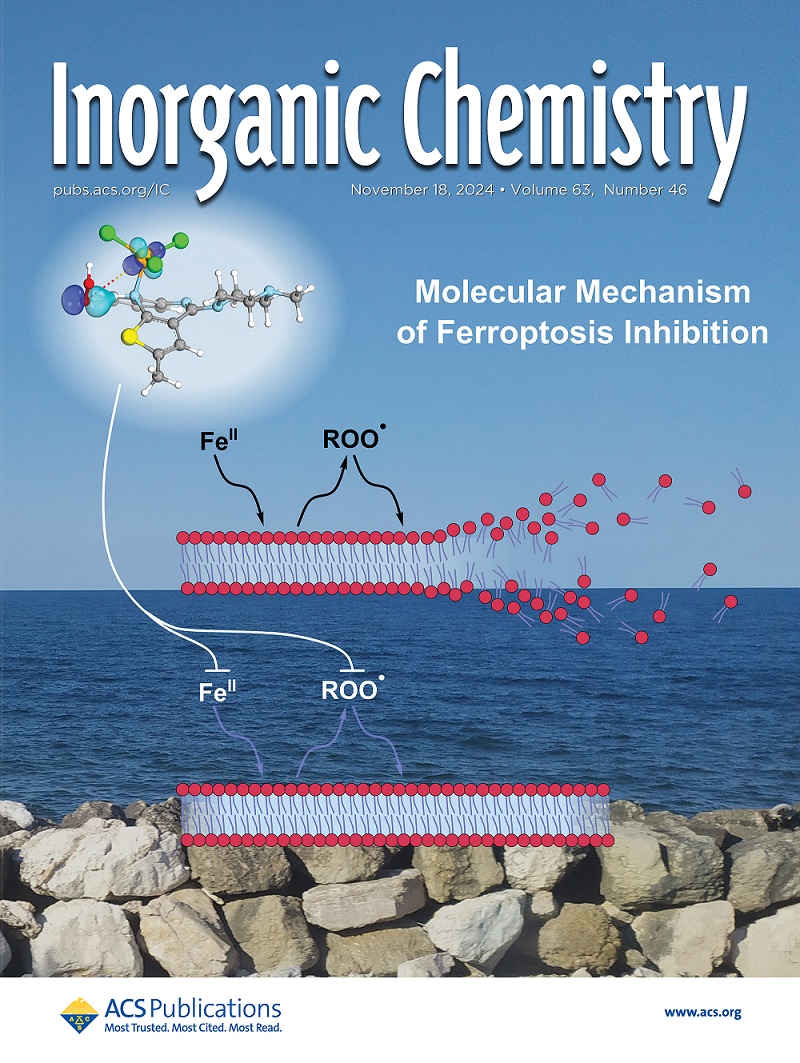Sc3+-Promoted Selective Oxygenation of Olefins with H2O2 by a Ligand-Free Iron Catalyst: Insights into the Nature of Active Oxidant.
IF 4.3
2区 化学
Q1 CHEMISTRY, INORGANIC & NUCLEAR
引用次数: 0
Abstract
Developing catalytic methods for the selective oxygenation of olefins remains an important objective in oxidation chemistry. Many iron-based catalysts have been reported in that pursuit. However, most catalytic systems rely on supporting ligands and often display nonselective oxidation via free radical pathways. Herein, we report a catalytic system combining a simple iron salt and Lewis acid (Sc(OTf)3) in acetonitrile for the selective epoxidation of a series of olefins with hydrogen peroxide. An iron(II)-scandium(III) triflate complex, formed in the reaction mixture, activates hydrogen peroxide, leading to a metal-based oxidant and not any radical species, thereby suggesting a mechanism different from the Fenton chemistry. An electrophilic oxidant is involved in the Sc3+-promoted epoxidation reactions. Quantum chemical analysis reveals the identity of the active oxidant responsible for the epoxidation reaction and elucidates the role of Sc3+ ions in the mechanistic pathway. The proximity of Sc(OTf)3 to the iron center helps in the O-O bond cleavage and generates the active oxidant required for the epoxidation reaction. This work demonstrates that the catalytic activity of simple iron salts in combination with Sc(OTf)3 in acetonitrile without the requirement of any supporting ligand does not involve free radicals, while affecting the selective oxygenation of olefins.无配体铁催化剂催化Sc3+促进烯烃与H2O2选择性氧化:对活性氧化剂性质的认识。
发展烯烃选择性氧化的催化方法仍然是氧化化学的一个重要目标。据报道,在这方面有许多铁基催化剂。然而,大多数催化系统依赖于支持配体,并经常通过自由基途径显示非选择性氧化。本文报道了一种在乙腈中由简单铁盐和路易斯酸(Sc(OTf)3)组成的催化体系,用于一系列烯烃与过氧化氢的选择性环氧化反应。在反应混合物中形成的铁(II)-钪(III)三酸盐络合物激活过氧化氢,导致金属基氧化剂而不是任何自由基,从而表明不同于芬顿化学的机制。一种亲电氧化剂参与了Sc3+促进的环氧化反应。量子化学分析揭示了环氧化反应的活性氧化剂的身份,并阐明了Sc3+离子在机制途径中的作用。Sc(OTf)3靠近铁中心有助于O-O键的裂解,并产生环氧化反应所需的活性氧化剂。本工作证明了简单铁盐与Sc(OTf)3在乙腈中结合的催化活性,不需要任何辅助配体,不涉及自由基,但影响烯烃的选择性氧化。
本文章由计算机程序翻译,如有差异,请以英文原文为准。
求助全文
约1分钟内获得全文
求助全文
来源期刊

Inorganic Chemistry
化学-无机化学与核化学
CiteScore
7.60
自引率
13.00%
发文量
1960
审稿时长
1.9 months
期刊介绍:
Inorganic Chemistry publishes fundamental studies in all phases of inorganic chemistry. Coverage includes experimental and theoretical reports on quantitative studies of structure and thermodynamics, kinetics, mechanisms of inorganic reactions, bioinorganic chemistry, and relevant aspects of organometallic chemistry, solid-state phenomena, and chemical bonding theory. Emphasis is placed on the synthesis, structure, thermodynamics, reactivity, spectroscopy, and bonding properties of significant new and known compounds.
 求助内容:
求助内容: 应助结果提醒方式:
应助结果提醒方式:


